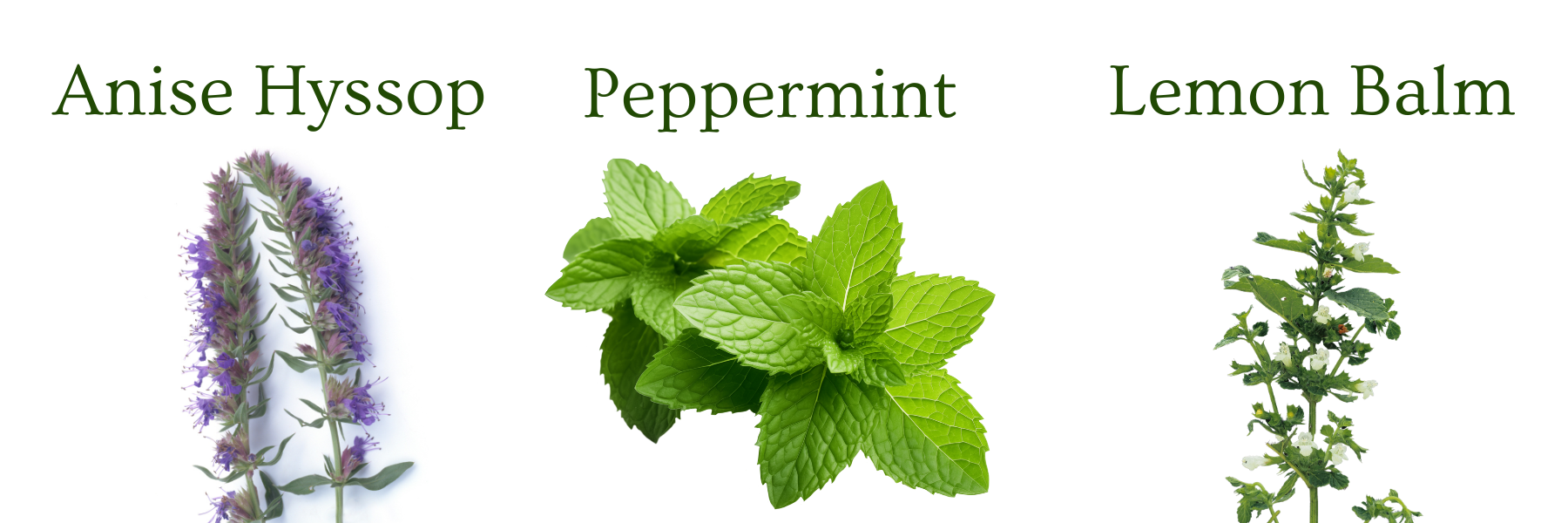3 Mints You Can Grow Yourself
Gardening can be daunting at first, and honestly even after years of experience. But there’s something wonderful about working with herbs you’ve tended to, harvested, and dried yourself. It’s worth it to try and I suggest starting with perennials.The reason for that is they will come back the following year, so you’re not starting your garden from scratch the next spring. I try to plant at least one new perennial each year to slowly build up my garden base. The mint family, or as it’s also known, the lamiaceae family, includes many perennial species that are easy to grow and have varying medicinal properties. Here are three mints you can grow yourself:
Featured from left to right: anise hyssop (purple flower heads), peppermint (close up of bright green leaves), lemon balm (flowering tops and leaves).
Peppermint (Mentha piperita): I’ll keep it real with you, I used to avoid peppermint because it was so common. When I was a wee baby herbalist, I wanted to work with exciting plants I’d never heard of before! Things from tropical and far off spaces! But nowadays? Peppermint is one of my most worked with plant friends. Its cooling nature makes it perfect for sweltering summer days as an iced tea or an herb water. Peppermint has an affinity for GI issues like bloating, gas, and nausea. It’s also just really delicious and has a strong flavor, which makes it a great addition to less appealing tea blends to spruce them up and make them more palatable. And it is absurdly easy to grow! It spreads enthusiastically by root so if you’re concerned about it taking over, try growing it in a large pot instead.
Anise hyssop (Agastache foeniculum): This is one of those plants that reminds you of the importance of scientific names because it is not, in fact, either an anise OR a hyssop. Nopeee, it’s a mint with a licorice/fennel flavor. Its stunning flowers are loved by pollinators. I’m always in the company of butterflies and pollen drunk bumblebees when I harvest this plant. Anise hyssop is my go to for a summer cold or flu. It’s a diaphoretic which helps with releasing heat from a fever, an expectorant which helps get out excess mucus, and a carminative which means it helps support digestion and get stuck things moving. Like peppermint, it does wonders for nausea. Anise hyssop spreads much less vigorously than peppermint though, so feel free to plant this lovely herb right in the ground and it’ll come back year after year.
Lemon balm (Melissa officinalis): Many years ago I read about an essential oil that was known to be super antiviral and a “must have” for a holistic first aid kit. I jumped online to order it and was shocked when I saw that a 5ml bottle of “Melissa officinalis” was over $100! What I didn’t realize was that it’s common name was lemon balm and I already had it thriving in my garden. Aside from being a useful antiviral, lemon balm has a sweet uplifting effect. It’s like drinking a cup of sunshine. In the dead of winter, a cup of lemon balm tea reminds us of that far off summer sun. It’s also a nervine, which means it nourishes and supports our nervous system. Lemon balm, like many mints, is so deliciously easy to grow. It’ll come back year after year and you can get multiple harvests per plant in the season. Just make sure to harvest before it flowers for the best flavor and profile of constituents.
There we have it, three easy to grow mints to try out this year. We’d love to see photos of these plant friends thriving in your garden so send them on over!
